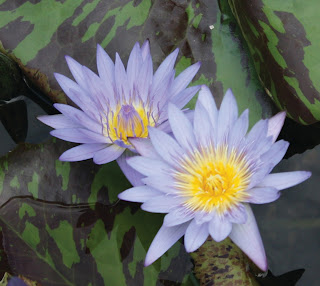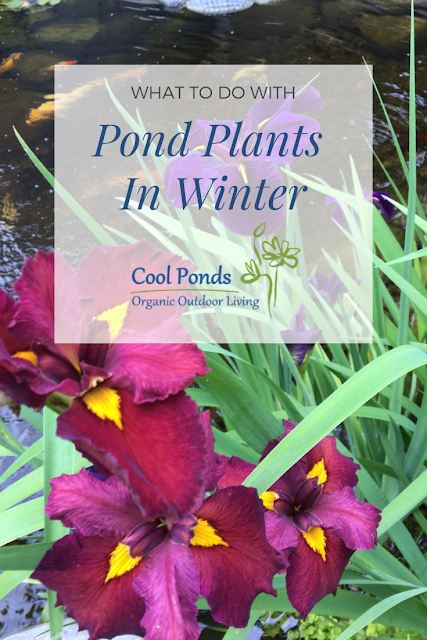What do you do with your plants in the winter?
A Little Time With Your Aquatic Plants Now Means Less Maintenance in the Spring
How you care for each of the plants in your water feature will depend on two characteristics: 1. What type of plant it is and 2. Is the plant hardy or tropical.
It's important to remember for tropical plants, either dispose of them or bring them in before the first hard freeze.
Hardy vs. Tropical
Any plant that can go through a winter in your area and then re-emerge the next year is hardy to your area. When you purchase a plant for your landscape or water garden it should be marked with it's "hardiness zone." In Indiana, we are either a 5a, 6a, or 6b zone. Marion county is a 6a. Check out the USDA map for the entire country here. Whether a plant is tropical or hardy will determine how you treat it for the winter.
 |
| These water iris are common to many ponds. They are hardy to zone 4 which includes all but the northern most US! |
Hardy Marginal Plants
Most hardy marginal plants (marginal plants have their roots planted under the water and the foliage above the water level) will over winter easily in your pond without much fuss. In the fall after they have died back, trim them back to about 6"-12" above the water level.
 |
| Canna are zones 7-10. They can be brought inside during Indiana winters. Outside they will survive from around Tennessee and farther south. |
Tropical Marginal Plants
Either bring these plants inside and treat them as house plants or discard them. If brought inside, there's no need to keep them completely submerged, just keep them very damp and near a sunny window. Read more about overwintering tropical plants here.
 |
| Hardy water lilies do just fine in at least 12" of water. |
Hardy Water Lilies and Lotus
Trim back the foliage of water lilies and lotus about 2" above the crown of the plant if possible. Make sure they are in at least 12" of water.
 |
| Tropical water lilies have unique colors and pads. Their leaves are serrated and might have variegation. |
Tropical Water Lilies
It's best just to treat a tropical water lily as an annual and replace it each year. It is possible to keep them, the difficulty lies in getting them ready to go back out in the spring. It takes a sunny 70 degree (water temperature) location to get them going before placing them outside again. Most homes just don't have place like that. Compare your tropical water lily to a hanging basket that you purchase each year. It's a nice treat!
 |
| Hornwort is an example of a submerged plants. |
Submerged Plants
Also referred to as oxygenators, some submerged plants will survive the winter others will not. It mostly depends on the severity of the winter. Trim them back to 2"-4" and keep them at an "ice-free" height. It seems the deeper in the pond the better their chances.
 |
| Water Hyacinth |
Floating Plants
Water hyacinth and water lettuce are not hardy. They should be removed in the fall as they begin to brown and die. They require very humid conditions which cannot be recreated inside a home.
Final Thoughts
Most hardy aquatic plants are fairly forgiving. They'll come back whether you trim them back or not.
Removing tropical plants before winter is a must.
Any time you can remove plant material that will decay over the winter and feed algae means a cleaner water feature in the spring.
That's great -- less time maintaining and more time enjoying!
 |
| Pickerel Rush is a must for any pond. Zone 5-9. |



Comments